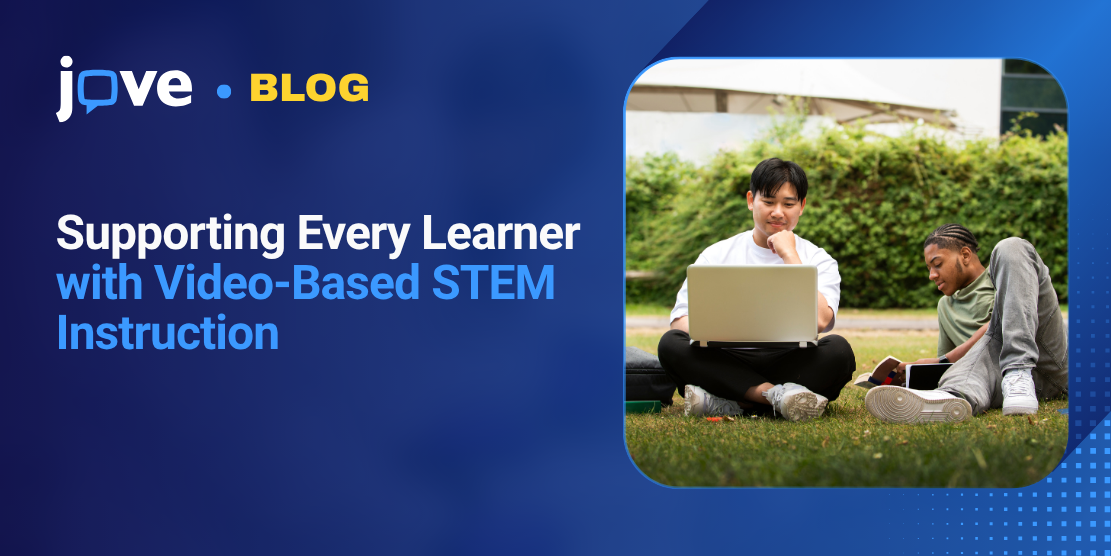Today’s classrooms bring together students with widely varying levels of preparation, language backgrounds, and confidence in laboratory settings. Adjusting every course to accommodate that variation can be challenging, but thoughtful use of teaching materials can make learning more consistent, effective, and inclusive for everyone.
The Universal Design for Learning (UDL)¹ framework offers a research-based way to make lessons more accessible without starting over. Its three principles—Engagement, Representation, and Action & Expression—help educators design flexible pathways into complex material.
Video-based instruction aligns closely with these ideas, helping students see, hear, and practice scientific methods in ways that strengthen understanding and skill development.
Engagement: Motivating Participation & Curiosity
UDL’s first principle focuses on how learners connect with material. Motivation, persistence, and curiosity vary across individuals, so students benefit when they can approach content in different ways.
Video offers an immediate entry point. Short demonstrations and narrated explanations show why a topic matters, helping students connect procedures to real applications. Teachers can organize video playlists to match course topics or lab sequences, supporting consistent preparation across groups and semesters.
- ⚙️ In Practice: Video-based instruction has been linked to higher levels of learner engagement.
Representation: Showing What Words Can’t
The second UDL principle, representation, highlights how information is presented. In STEM fields, many key processes—like chemical reactions, tissue preparation, or microscopy—are easier to understand when learners can observe them rather than imagine them from text.
Through narrated visuals, subtitles, and transcripts, students can access information through multiple channels. Audio descriptions ensure that key visual details are conveyed clearly, while subtitles in multiple languages support diverse classrooms. The ability to adjust playback speed also lets learners review content at a pace that suits their understanding.
These features promote flexibility and comprehension, helping all students engage with complex material more effectively. Research shows that pairing visual and verbal explanations can improve comprehension and reduce cognitive load in science education.2
- ⚙️ In Practice: Visual explanations have been linked to stronger conceptual understanding and test performance.
Action & Expression: Building Confidence & Skill
The third UDL principle focuses on how students demonstrate understanding. Some express what they know best through written reports, others through problem solving, presentation, or performance in the lab.
Video-based learning tools can support these different approaches. Learners can review demonstrations while writing lab plans, preparing for practical sessions, or analyzing their own results. Teachers can embed quizzes to check comprehension or prompt reflection before or after activities.
In courses where students face limited lab access or time, video also functions as a scaffold that builds procedural familiarity before hands-on work begins.
- ⚙️ In Practice: Use of video demonstrations has been linked to improved lab performance and learner confidence.
Putting UDL into Practice
When teaching materials align with these principles, learning becomes more flexible and outcomes more consistent. Video makes this possible by presenting information clearly, supporting preparation, and giving students multiple ways to engage with complex ideas. It also allows instructors to adapt lessons efficiently, not by adding more work but by choosing formats that reach more learners.
Flexible teaching is not about replacing traditional methods; it's about strengthening them. When students can preview procedures, revisit demonstrations, or access material in their own language, they participate more confidently and retain what they learn. Over time, these small design choices lead to measurable improvements in understanding, performance, and participation.
See how visual resources support flexible teaching and accessible science.
Request a curated video playlist aligned with your syllabus.
- CAST. (2024). Research evidence for the UDL Guidelines. https://udlguidelines.cast.org/more/research-evidence/
- Fiorella, L., & Mayer, R. E. (2018). What works and doesn’t work with instructional video. Computers in Human Behavior, 89, 465–470. https://doi.org/10.1016/j.chb.2018.07.015




